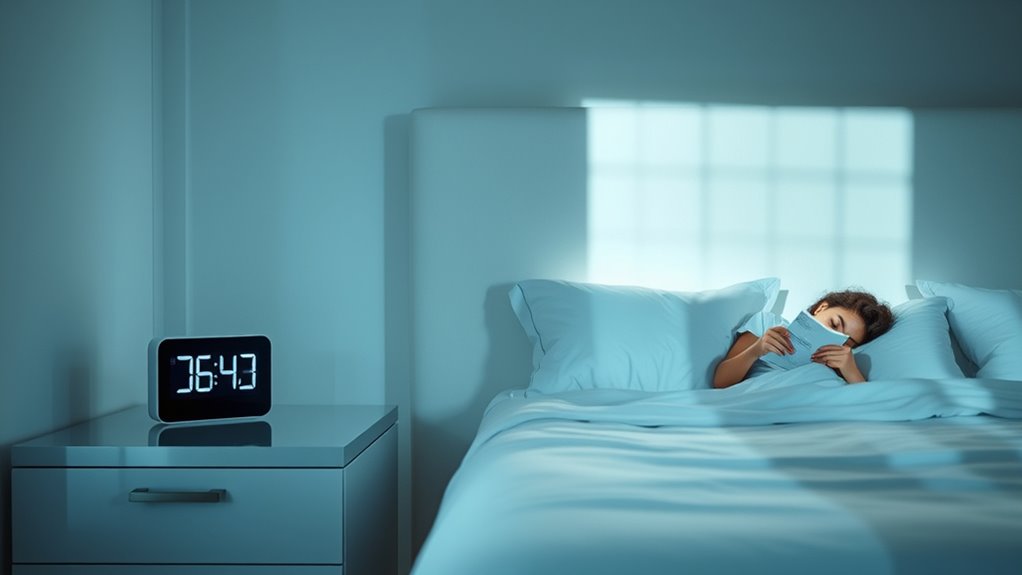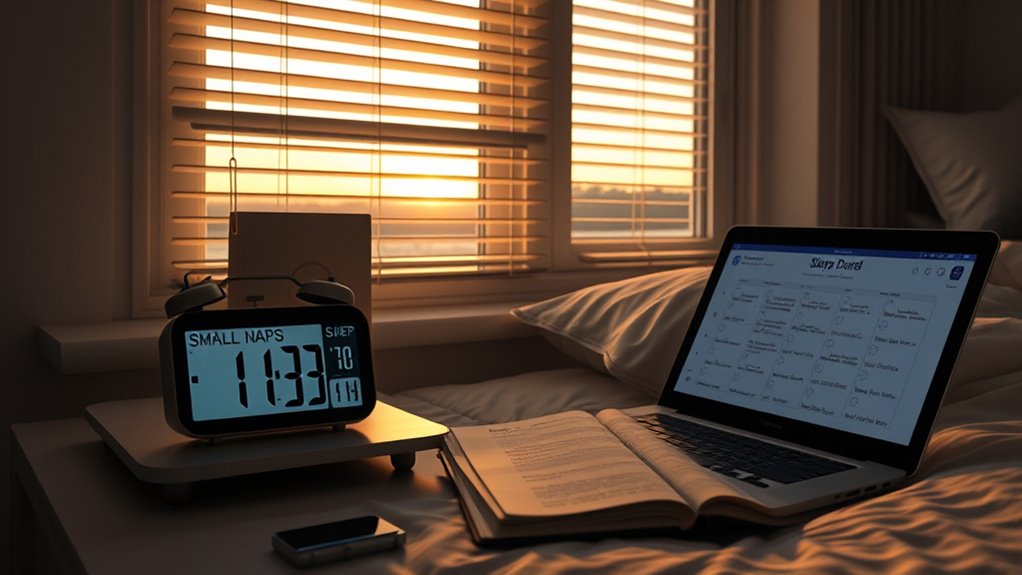Polyphasic sleep, which breaks sleep into multiple short periods instead of one long night, is seeing a modern revival due to its potential to boost productivity and free up time. While some people find it improves sleep efficiency and maximizes REM stages, it can also disrupt natural rhythms and cause fatigue or health issues if not managed carefully. Before trying this unorthodox schedule, it’s important to weigh the benefits and risks—more details await if you keep exploring.
Key Takeaways
- Polyphasic sleep divides rest into multiple shorter periods, potentially increasing sleep efficiency and freeing up more daytime hours.
- It mimics ancient and traditional practices but can disrupt circadian rhythms, risking health issues if not carefully managed.
- Suitability varies; consider personal health, lifestyle, and social factors before attempting polyphasic sleep routines.
- Transitioning requires gradual adjustment, proper planning, and awareness of signs of fatigue or sleep deprivation.
- Consulting healthcare professionals is recommended to evaluate risks and ensure safe implementation of polyphasic sleep.
What Is Polyphasic Sleep and How Does It Differ From Monophasic Rest

Polyphasic sleep refers to a sleep schedule that divides your rest into multiple shorter periods throughout the 24-hour day, unlike the traditional single long sleep session known as monophasic sleep. This approach alters your sleep architecture, often reducing total sleep time but shifting how you cycle through REM and non-REM stages. Because of these changes, your dream recall can vary; some people find it easier to remember dreams during brief naps, while others notice less vivid dreaming overall. By adjusting your sleep pattern, you might experience more frequent shifts between sleep stages, impacting both rest quality and dream experiences. Incorporating elements of bedroom design, such as creating a calming environment, can help optimize the quality of your sleep and support your sleep schedule adjustments. Understanding these differences helps you decide if polyphasic sleep suits your lifestyle and goals.
The Historical Roots and Modern Resurgence of Polyphasic Schedules

You might notice that polyphasic sleep isn’t just a modern trend; it has deep roots in ancient cultures. Throughout history, people experimented with different sleep patterns to maximize rest and productivity. Today, a resurgence of these schedules reflects a desire to optimize sleep in our fast-paced world. Understanding the sleep cycle and how it influences overall health can help individuals tailor their sleep habits more effectively. Advances in automation technologies in various industries demonstrate how innovative approaches can streamline routines, similar to how adjusting sleep schedules can improve daily functioning. Recognizing the biological basis of sleep patterns can further inform how individuals adapt polyphasic schedules to suit their lifestyles, especially as ongoing research uncovers more about circadian rhythms and their impact on health.
Ancient Sleep Practices
Throughout history, various cultures have embraced sleep patterns that differ markedly from the modern monophasic routine, often dividing sleep into multiple periods throughout the day and night. For example, ancient Greeks and Romans practiced segmented sleep, with a first sleep, a waking period, then a second sleep. Similarly, many traditional societies in Africa and Asia followed polyphasic schedules, believing that spreading sleep improved overall sleep quality and adapted better to daily activities. These practices often resulted in shorter, more frequent sleep episodes, which they found maintained or even enhanced sleep quality. Notably, these routines supported sufficient sleep duration while aligning with natural circadian rhythms. Today, some modern polyphasic schedules draw inspiration from these ancient practices, challenging the idea that continuous sleep is essential for health and productivity. Additionally, recent research into sleep patterns and Deaf Vibes suggests that non-monophasic sleep can be effective for certain individuals, especially when tailored to personal biological rhythms. Some experts argue that embracing flexible sleep schedules can lead to improved sleep efficiency and overall well-being, especially for those with unconventional lifestyles.
Modern Revival Trends
The resurgence of polyphasic sleep schedules today reflects a growing interest in revisiting ancient practices to optimize modern lifestyles. Historically, these sleep patterns have roots in diverse cultures, from siesta traditions in Spain to segmented sleep in pre-industrial Europe. The historical context shows that polyphasic schedules weren’t always seen as unusual but were once common. Today’s revival is influenced by cultural shifts emphasizing productivity and efficiency, fueled by the internet and social media. Enthusiasts share experiences and tips online, sparking curiosity around the world. This modern trend blends historical wisdom with contemporary goals, challenging the conventional monophasic sleep cycle. As a result, you’re seeing a cultural shift that questions long-held sleep norms and explores alternative approaches rooted in both history and innovation. Additionally, some researchers are exploring the biological impacts of these sleep patterns to better understand their effects on health and cognitive function, often using scientific studies to support emerging theories.
Scientific Evidence and Myths Surrounding Polyphasic Rest

Despite limited large-scale scientific studies, many claims about polyphasic sleep persist, fueling both curiosity and skepticism. Some proponents argue it enhances productivity and reduces sleep needs, but these ideas often overlook the risks of sleep deprivation. Scientific evidence supporting polyphasic sleep’s health benefits remains scarce, and experts warn that disrupting natural sleep cycles can impair cognitive function and emotional well-being. Many myths circulate, like the idea that you can adapt quickly or avoid sleep debt altogether. However, myth debunking reveals that consistent, uninterrupted sleep is essential for your health. While some individuals report success with polyphasic patterns, these anecdotal accounts don’t replace rigorous research. Approaching polyphasic sleep with caution and skepticism ensures you don’t compromise your well-being based on unsupported claims. Additionally, understanding the importance of toilet flushing mechanisms and maintaining proper sleep hygiene can help optimize your overall health and daily function. Furthermore, recent advances in AI Discoveries suggest that technological innovations may someday influence sleep research and health optimization strategies. Recognizing the contrast ratio in sleep studies can help clarify how different sleep patterns impact overall quality and recovery. Moreover, considering the role of filtration and pump protection, which is vital for maintaining equipment efficiency, can serve as a reminder that proper systems maintenance parallels the importance of healthy sleep practices in supporting overall well-being.
Common Types of Polyphasic Sleep Patterns and Their Characteristics

Polyphasic sleep patterns vary widely, each designed to divide sleep into multiple periods rather than a single extended stretch. These schedules aim to optimize your sleep cycle by reducing overall sleep time while still hitting key dream stages. The most common patterns include the Everyman, which combines a core sleep segment with several shorter naps, and the Uberman, consisting solely of short naps throughout the day. Each pattern affects how you cycle through REM and non-REM stages, impacting dream frequency and depth. Some schedules prioritize rapid eye movement (REM) sleep to maximize restorative benefits, while others focus on minimizing total sleep time. Understanding these types helps you evaluate whether adapting to a polyphasic routine aligns with your lifestyle and sleep needs. Additionally, sleep architecture can be significantly altered by these patterns, influencing overall sleep quality and the body’s natural rhythms. Moreover, circadian rhythms play a crucial role in how effectively your body can adapt to such unconventional sleep schedules, potentially affecting the likelihood of experiencing prophetic dreams or other vivid dream phenomena.
Potential Benefits and Risks of Adopting a Polyphasic Routine

Adopting a polyphasic sleep schedule might improve your sleep efficiency by reducing total sleep time, but it can also disrupt your circadian rhythms. This disruption can lead to feelings of fatigue and impact your daily functioning. Weighing these potential benefits against the risks is key before making any changes to your sleep routine. Additionally, understanding the sleep cycle and how it interacts with your body’s natural rhythms can help you determine whether polyphasic sleep is a suitable approach. Incorporating mindful sleep practices can also support a healthier transition if you choose to explore this routine. Being aware of retail hours for sleep-related products or resources may assist in planning your schedule effectively. Recognizing essential oils for sleep might also help promote relaxation during your adjustment period.
Increased Sleep Efficiency
When you switch to a polyphasic sleep schedule, you may notice a significant increase in sleep efficiency, meaning you spend more time resting and less time awake during your sleep periods. This often leads to improved sleep quality because your body becomes more effective at entering restorative sleep stages quickly. As a result, you might feel more refreshed and alert during your waking hours. Enhanced sleep efficiency can boost your energy levels throughout the day, reducing fatigue and increasing productivity. Additionally, some individuals find that their sleep quality improves with practice, although responses can vary. Properly optimizing sound design techniques in your environment, such as using ambient sounds or white noise, can also support better sleep. However, keep in mind that this efficiency depends on consistent adherence and individual response. While some people thrive with polyphasic routines, others may find their sleep quality suffers over time, making it essential to monitor your own health and adjust accordingly. Moreover, understanding how cultural narratives influence sleep habits can help tailor routines that align with personal and social needs. Maintaining a balanced sleep schedule is crucial for long-term health and well-being.
Disrupted Circadian Rhythms
Disrupted circadian rhythms are a common consequence of shifting to a polyphasic sleep schedule, as your internal clock struggles to synchronize with unusual sleep-wake cycles. This circadian disruption can lead to sleep deprivation if your body can’t adapt quickly, causing fatigue and decreased alertness. You might find your mood fluctuates, and cognitive performance drops due to inconsistent sleep timing. The table below highlights potential benefits and risks:
| Potential Benefits | Risks |
|---|---|
| Increased flexibility in daily routines | Chronic circadian disruption |
| Shorter overall sleep duration | Higher likelihood of sleep deprivation |
| Enhanced productivity during wake periods | Long-term health impacts, including metabolic issues |
Additionally, sustained circadian disruption has been linked to various health risks such as hormonal imbalances and cardiovascular problems. It is important to recognize that disrupted circadian rhythms can also impair immune function, making the body more susceptible to illness. Understanding the biological clock can help mitigate some of these adverse effects by aligning sleep patterns more closely with natural rhythms. Moreover, awareness of sleep regulation mechanisms can inform strategies to reduce negative outcomes associated with irregular sleep schedules.
Potential for Fatigue
Switching to a polyphasic sleep schedule can substantially increase your risk of fatigue, especially during the adjustment period. Sleep deprivation may occur if your body struggles to adapt, leading to decreased alertness and impaired performance. It’s essential to contemplate fatigue management strategies to prevent exhaustion. Without proper planning, you might experience:
- Persistent daytime drowsiness
- Reduced cognitive function
- Mood swings and irritability
- Increased likelihood of accidents
While some find they adapt over time, others face ongoing fatigue issues that compromise health and productivity. Recognizing these risks helps you decide if the potential benefits outweigh the dangers. Be prepared for a challenging transition, and prioritize rest to minimize adverse effects. Incorporating practices like yoga can help improve sleep quality and support your transition.
Practical Considerations for Transitioning to Polyphasic Sleep

Moving to a polyphasic sleep schedule requires careful planning and gradual adjustment. You should prioritize sleep hygiene by maintaining a consistent sleep environment and avoiding screens before naps. Napping techniques, like short, scheduled naps, help your body adapt smoothly. To stay organized, consider this plan:
| Step | Action | Tips |
|---|---|---|
| 1 | Adjust sleep gradually | Shift bedtime in 15-min steps |
| 2 | Schedule naps consistently | Use alarms for accuracy |
| 3 | Monitor sleep quality | Keep a sleep journal |
| 4 | Optimize sleep environment | Dark, cool, quiet room |
| 5 | Stay flexible and patient | Expect some trial and error |
These practical steps can ease your transition and improve your chances of success.
Real-Life Experiences and Success Stories

Many individuals have successfully adopted polyphasic sleep schedules, sharing their experiences to inspire others. They often report overcoming initial sleep deprivation, which can be intense before the body adjusts. Some enthusiasts claim they’ve gained extra waking hours, boosting productivity and creativity. A few have explored dream manipulation during short naps, enhancing lucid dreaming experiences. Success stories highlight that consistent routines help reduce fatigue over time. However, some users admit that irregular schedules caused temporary cognitive fog or irritability. Many emphasize the importance of listening to your body and adjusting as needed. These real-life accounts demonstrate that with discipline, polyphasic sleep can be sustainable, disclose more time and even changing how you perceive dreams and sleep cycles.
Is Polyphasic Sleep Right for You? Key Factors to Think About

Deciding if polyphasic sleep suits you requires careful consideration of your lifestyle, health, and personal goals. It’s important to recognize that disrupting your typical sleep pattern can lead to sleep deprivation if not managed properly, affecting your mood, focus, and overall health. Consider whether your daily schedule allows for multiple sleep periods and if you can maintain consistency. Cultural implications also matter; some cultures view polyphasic sleep as unconventional or even problematic. Think about your long-term commitments and social environment. If you’re prone to sleep issues or have health concerns, consulting a healthcare professional is wise. Ultimately, only you can determine if the potential benefits outweigh the risks, especially given the challenges of adapting to a new sleep rhythm.
Frequently Asked Questions
Can Polyphasic Sleep Improve Productivity Long-Term?
Polyphasic sleep might boost your productivity short-term by optimizing your sleep schedule, but its long-term effects on energy management are uncertain. You could find more efficient sleep cycles that help you stay alert and focused, but it requires careful adjustment. Keep in mind that individual responses vary, so monitoring how your body reacts is essential. Ultimately, consistency and listening to your body’s signals are key to maintaining sustainable productivity.
Are There Specific Health Conditions That Contraindicate Polyphasic Sleep?
If you have sleep disorders or chronic illnesses, polyphasic sleep might not be suitable for you. Conditions like insomnia, sleep apnea, or heart issues can worsen with irregular sleep patterns. You should consult your healthcare provider before trying polyphasic sleep, as they can advise whether it’s safe based on your specific health circumstances. Prioritizing your health is essential, so don’t risk disrupting your recovery or condition.
How Does Polyphasic Sleep Impact Mental Health?
Polyphasic sleep can impact your mental health by affecting emotional regulation and increasing the risk of sleep deprivation. When you don’t get enough restorative sleep, your mood may fluctuate, and stress levels rise. You might find it harder to manage emotions and stay focused. If you’re considering this sleep pattern, be aware that disrupting your natural sleep cycle could lead to mental health challenges over time.
What Are the Best Tools or Apps to Track Polyphasic Sleep?
When tracking your polyphasic sleep, using reliable sleep tracking apps can help you monitor your sleep patterns effectively. Look for apps with features like sleep cycle analysis and nap logging. Recommendations include Sleep Cycle, Pillow, and AutoSleep, as they provide detailed insights into your sleep quality and duration. These tools make it easier to optimize your schedule and guarantee you’re getting restorative rest during your polyphasic sleep routine.
Is Polyphasic Sleep Suitable for Shift Workers or Frequent Travelers?
Did you know that nearly 20% of the workforce are shift workers, facing unique sleep challenges? Polyphasic sleep might help, but it’s not optimal for everyone. As a shift worker or frequent traveler, you’ll need effective travel adaptation strategies and consistent routines. While polyphasic sleep can offer flexibility, it’s essential to prioritize quality rest and listen to your body’s signals to avoid fatigue and health issues.
Conclusion
Deciding to try polyphasic sleep is like planting a new seed—you must nurture it carefully to see if it blooms. While some find it revitalizing, others face challenges that can overshadow the benefits. Listen to your body’s signals and weigh the risks. Ultimately, whether you embrace this schedule or stick with tradition, remember that your sleep is the canvas—choose the pattern that paints your life in health and vigor.









